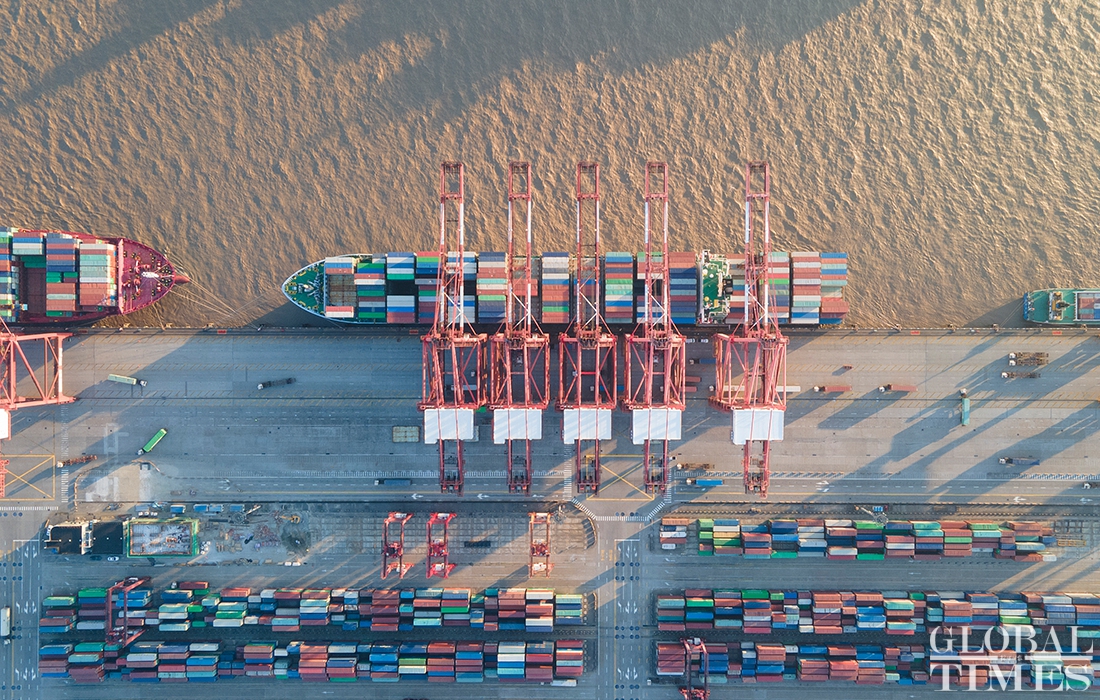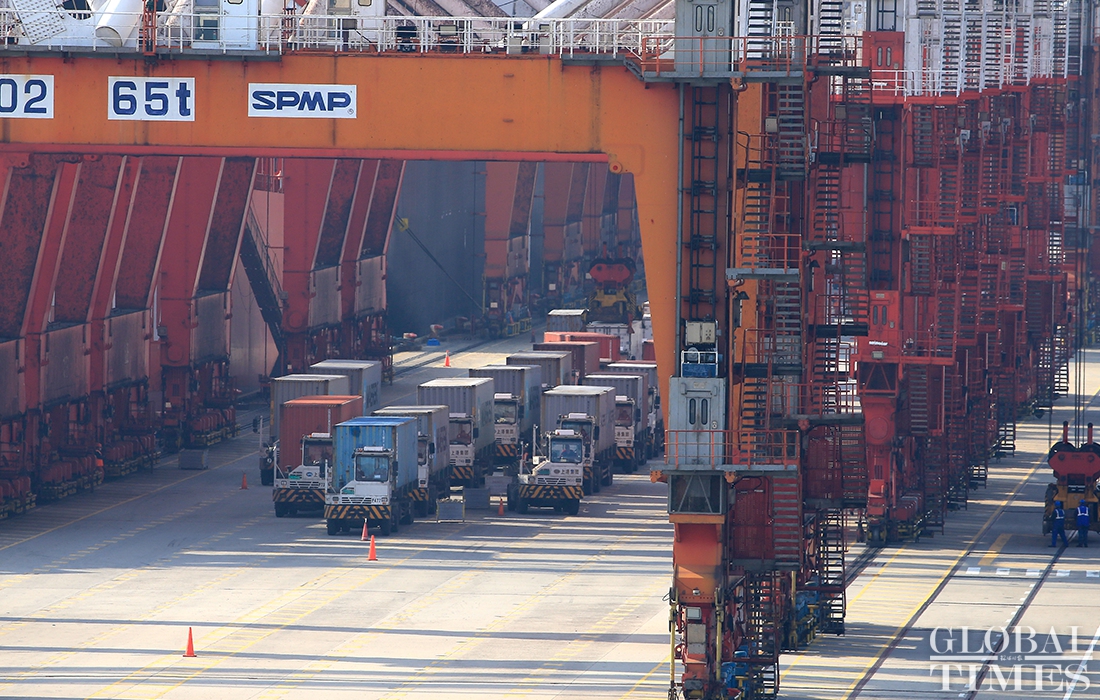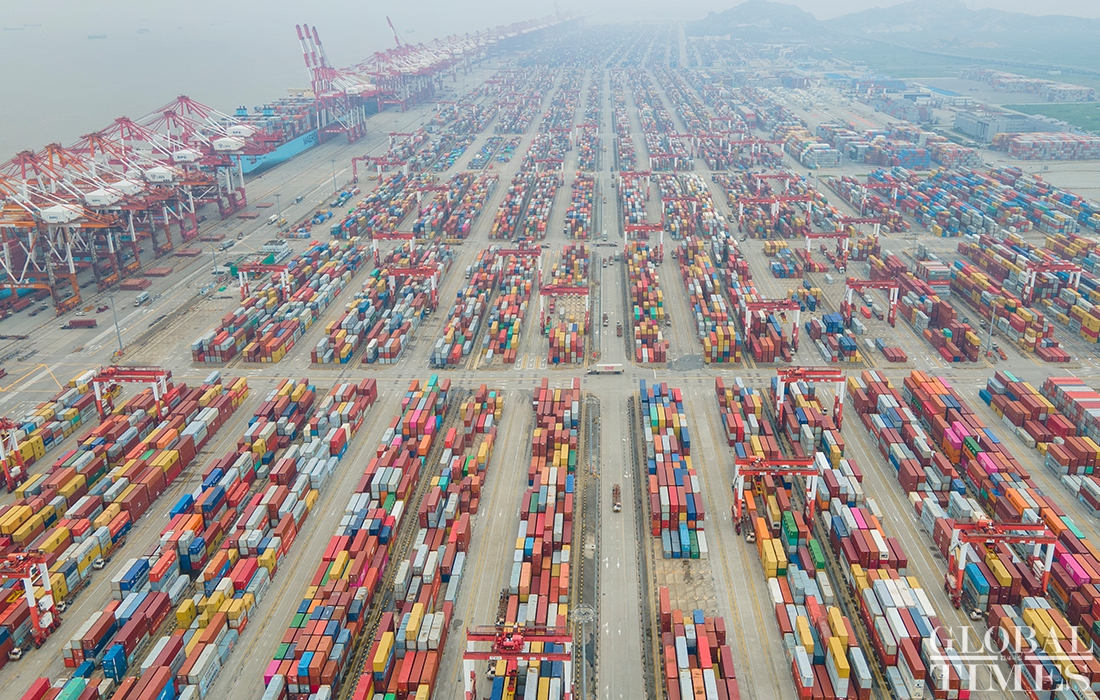Freight rate of American routes rises with more orders from US
By GT staff reporters Source: Global Times Published: 2020/9/22 21:13:40

Photo: Yang Hui/GT
On Saturday morning, lines of container lorries were waiting to discharge cargo at the Shanghai International Port (Group) Co (SIPG), while there were also many empty trucks and ships ready to load goods. Transport vehicles were moving around frequently, and about three or four cargo ships of super-large sizes sailed in to unload cargo on that same day.
Such a busy scene is not just seen in Shanghai but also at other major ports like Ningbo in East China's Zhejiang Province as well as factory floors in manufacturing powerhouses in South China's Guangdong Province. Beyond a solid economic recovery from the impact brought by COVID-19, what's driving such a rush was also surging demand from the US for goods from personal protective gear to smart watches to computers ahead of an ordinary peak export season for Christmas.
What makes this year's peak season extraordinary is that it underscored the apparently unbreakable trade relationship between the world's two biggest economies, despite profound disruptions brought by the COVID-19 pandemic as well as repeated threats from US President Donald Trump to decouple US economy from China.
According to data provided by the SIPG to the Global Times, the surge of containers on China-US trade route has become a "highlight" in SIPG's trade recovery since the third quarter.
In July, the amount of containers on China-US trade route surged 24 percent on a monthly basis to 489,000 standardized containers. On a yearly basis, the numbers declined by about 4 percent. The number rose to 490,400 in August, a positive year-on-year growth for the first time this year, SIPG data showed.
US politicians, including US President Trump, have increasingly called for a US-China economic decoupling, however, business communities from both sides have acted differently.
The cost of shipping by sea from Shanghai to the west coast of the US has surged to an eight-year peak in recent days, almost doubling from the beginning of 2020, according to media reports. Many shipping companies have witnessed the freight rate of American routes continue soaring and booking is difficult as the freight capacity hardly meets the rapid growth of market demand.
August-September is usually freight shipping peak season between China and the US. Though the coronavirus outbreak disrupted the production schedule of many factories, growing demand for the upcoming Thanksgiving and Christmas holidays in the US has driven up export volume for the Chinese manufacturers.
Other Chinese ports have also seen their shipment handling volume soar lately, driven by fast growth of export activities. Ningbo Zhoushan Port Co, the operator of one of the main Chinese ports for shipments heading to the US, revealed earlier in September that the Ningbo-Zhoushan Port was estimated to have handled 2.81 million twenty-foot equivalent unit containers in August, up 7.59 percent year-on-year.

Photo: Yang Hui/GT
Growing demand
"We have felt slightly busier over the past two months than before as the Christmas season is approaching," Huang Jinyun, general manager of Shenzhen-based smart-watch maker Aibaohu Tech Co, told the Global Times.
The company's exports to the US have been up roughly 10-20 percent, according to Huang, and Christmas-related items take the lion's share of its products. Exports to Europe and the US account for 40 percent of its total exports and the US alone makes up 15-20 percent.
China has seen its exports increase for the third consecutive month in August, as the official data recently showed, driven by record shipments of medical supplies and electronic products, according to Reuters.
For instance, China is now accounting for more than 85 percent of all US imports in the category dominated by N-95 respirators, disposable and non-disposable face masks, surgical drapes and surgical towels, Forbes reported on Saturday. Besides, textile and personal protective equipment (PPE), computer parts also increased.
With the worldwide shortage of face masks amid the pandemic, Arun, a consumer electronic product manufacturer in Dongguan, like many other companies, started mask production in February, the company's deputy general manager surnamed Sun told the Global Times in a recent interview.
Thanks to Dongguan's integrated industries that guarantee the access to many types of materials for mask production, the factory could quickly move to this business, and "a big portion of our masks are now exported, most of which went to the US as of now," Sun said.
The COVID-19 pandemic has caused overseas orders to drop for many manufacturers, but orders of products that are much in need for people working from home, such as laptops and video game consoles have seen a rebound, Emily Zhang, sales manager of stamping parts supplier Kinyet in Dongguan, told the Global Times.
"Our orders for the metal parts of laptops have seen a 10-15 percent year-on-year growth so far; the demand for parts for video game consoles are also higher than the same period last year," Zhang said.
Most of these orders are from the US, she said, adding that despite the additional tariffs, strong US demand still requires China's industrial chain.

Photo: Yang Hui/GT
'Decoupling' unlikely
The robust demand for Chinese goods stands in contrast with insufficient shipping capacity. The cost of shipments to the US, for Huang's company, has jumped about 10 percent, although that's down from a 40-percent surge in April-May. Further, freight shipping takes a longer time now, affecting the company's collection of outstanding payments.
The cost of container shipments from Shanghai to the west coast of the US has more than doubled to $3,348 per 40-foot equivalent unit (FEU) container in August from an average of $1,530 per FEU throughout 2019, according to Shanghai-based news portal thepaper.cn, citing Shanghai Ship Exchange.
As of September 11, the reading surged to $3,813 per FEU, its highest level since 2009.
Rates are also rising for shipments to other destinations, said a Chinese import-reliant miscellaneous goods merchant in Mexico City who gave his surname as Yu. This, added to the yuan's appreciation against the US dollar, dents importers' margins, he told the Global Times.
The economies of the US and China are highly complementary, after decades of development, the two countries' supply chains and industrial chains are tightly connected now, Sang Baichuan, director of the Institute of International Business at the University of International Business and Economics, told the Global Times on Monday.
American companies have also been ignoring the rhetoric of decoupling reiterated by the Trump administration, as a recent survey conducted by the American Chamber of Commerce with US firms in China showed a majority of companies have no plans to relocate their plants out of China, in spite of higher tariffs from a yearlong trade war, according to media reports.
It also raised a question about whether the two largest economies could really decouple, when US consumer spending has been rising strongly, boosting expectations for a third quarter recovery, it would also remain dependent on China's manufacturing infrastructure.
Despite the impact on the US economy from the pandemic, due to its advantages including comprehensive national strength and solid industrial foundations, US economy will eventually recover, and its position as the world's leading power will remain for a long time, according to some analysts.
"So, after the pandemic, China still needs to push for deepened cooperation with the US," Sang noted.
Newspaper headline: Busy scenes at Chinese ports contradict Trump's decoupling call
RELATED ARTICLES: